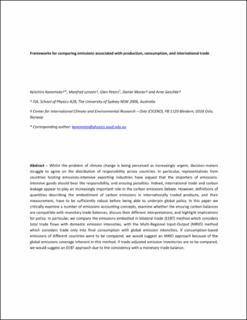Frameworks for Comparing Emissions Associated with Production, Consumption, And International Trade
Journal article, Peer reviewed
Submitted version
Permanent lenke
https://hdl.handle.net/11250/2760150Utgivelsesdato
2012Metadata
Vis full innførselSamlinger
- Journal articles [478]
Sammendrag
While the problem of climate change is being perceived as increasingly urgent, decision-makers struggle to agree on the distribution of responsibility across countries. In particular, representatives from countries hosting emissions-intensive exporting industries have argued that the importers of emissions-intensive goods should bear the responsibility, and ensuing penalties. Indeed, international trade and carbon leakage appear to play an increasingly important role in the carbon emissions debate. However, definitions of quantities describing the embodiment of carbon emissions in internationally traded products, and their measurement, have to be sufficiently robust before being able to underpin global policy. In this paper we critically examine a number of emissions accounting concepts, examine whether the ensuing carbon balances are compatible with monetary trade balances, discuss their different interpretations, and highlight implications for policy. In particular, we compare the emissions embodied in bilateral trade (EEBT) method which considers total trade flows with domestic emission intensities, with the multi-regional input-output (MRIO) method which considers trade only into final consumption with global emission intensities. If consumption-based emissions of different countries were to be compared, we would suggest an MRIO approach because of the global emissions coverage inherent in this method. If trade-adjusted emission inventories were to be compared, we would suggest an EEBT approach due to the consistency with a monetary trade balance.
